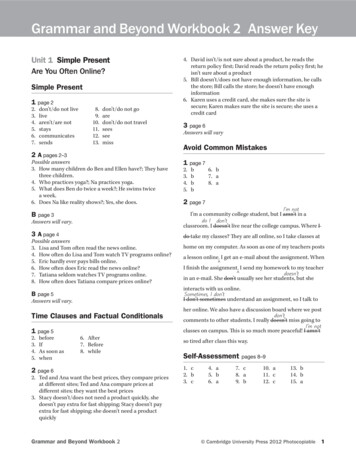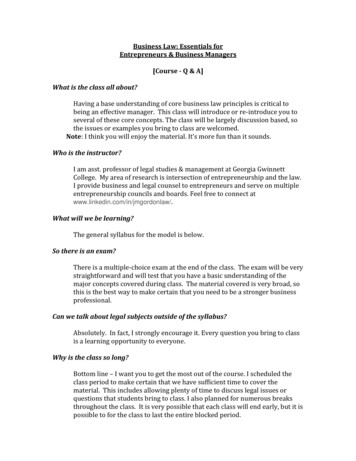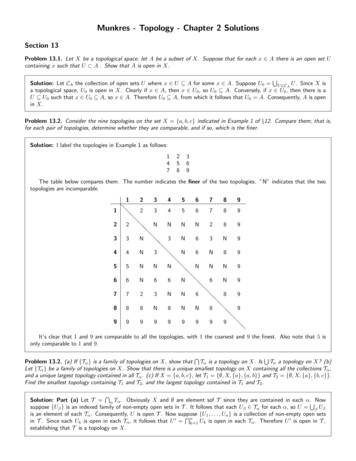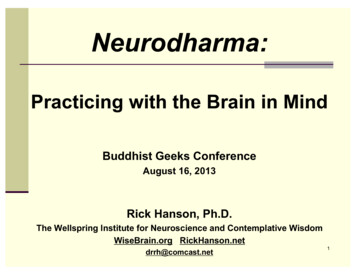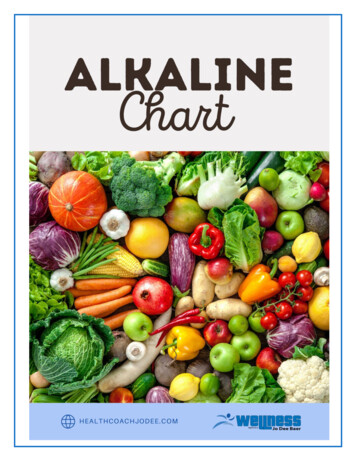
Transcription
Let me introduce you to the pH ScaleSo you get the most of this handy resource, it’s important that you understandwhat the pH scale is. To make a complex concept simple, the pH scale is ameasure of the acidity or alkalinity of a substance. It ranges from 1 being highlyacidic (picture acid melting through cars), through to 14, which is highly alkaline(picture drain cleaner), and 7 being neutral.For the human body to function effectively it’s essential that our body stays asclose to 7.4 as possible.Let me introduce you to the pH ScaleAs you learned a minute ago, it’s essential that the human body stays as closeto pH 7.4 as possible. The trouble however is that the modern diet as well asother factors such as stress, is that they are highly acidic by nature.Now while your body won’t change its pH from its ideal level, how it achievesthis is very scary. As your pH is the most important factor to your body’s survival, it will do anything needed to maintain it such as leach calcium from yourbones, and store excess acid inside Tumors and Cysts.Other effects of a highly acidic body include increased risk of cancer, chronicdisease, and even inflamed allergies. Personally when I changed to an alkalinediet my hayfever which I’d previously been taking daily medication for clearedup within weeks.
When following the Alkaline Diet, you won’t improve your bodies state to beingmore alkaline than 7.4. However what will happen is that your body will be ableto maintain this state with ease, and can instead focus its energy and resourcestowards improving your health, healing illnesses, and giving you the total vitalitythat we were naturally meant to live with.As you can see, the benefits of the Alkaline Diet are enormous, yet if you’vebeen following it for long you’ll know that finding accurate information about thefoods to eat is near impossible.With all these different alkaline charts whoare you meant to trust?When you’re starting the alkaline diet the first thing you need to understand iswhich foods are acid forming and what in alkaline forming. By simply knowingthe right foods to eat, in order to alkalize your body, you are 50% of the way toliving a successful Alkaline lifestyle.However if you’ve looked at many of the charts or ‘alkaline cook books’ outthere on the market, you may be stuck wondering why there is so much conflicting information. This is essentially because there are 2 methods of determiningthe alkalinity or acidity of food in your body.These two methods are the PRAL & Live Blood Methods.Method One: PRAL.The PRAL (Potential Renal Acid Load) method is quite accurate for measuringthe alkalinity of food in nature, however it is near useless for how food is in yourbody. Let me explain.In the PRAL method foods are burned and then the pH of the ash that is leftover is measured. The trouble with this method is that it also burns off 2 of themost highly acidic compounds for the human body - Yeast and Sugar. Thisresults in many foods such as fruits being called ‘alkaline’ when in fact in the human body they are acidic or highly acidic because of the large amounts sugarsand yeasts that they contain.
Method 2: Live Blood Analysis.The second method isn’t as widely used as it is harder to measure in hard facts,but rather needs an expert’s eye to analyse. The live blood method is basedupon analysing the patient’s blood after they consume certain foods and thengauging how they affect the human body.For our alkaline food chart we’ve used the work of Dr Robert Young, a worldleading bio-chemist who deeply understands the effect of pH on the humanbody. His data has been collected from over 40,000 live blood analysis testsand is the most accurate around. We then take his data and combine it withour deep understanding the chemical reactions in the human body - which we’llteach you how to do in a minute - to determine the first alkaline food list you cantrust.Alkaline Foods VS Alkaline FORMING FoodsAs we touched on above, the key reason for conflicting information on theinternet is that some people measure the pH of food, while we prefer to measure how food affects the pH of your body. This diet is designed to alkalise yourbody’s pH afterall.What Makes Foods Alkaline or AcidicForming?At the core there are 2 core factors that effect if a food is Alkaline or Acidic. Ofcourse there are many more smaller factors at play as well, but for the purposeof following the Alkaline Diet you don’t need to go into this level of detail.The 2 main factors that make foods Alkaline or Acid are:Sugar Content - Whether it is Glucose, Fructose, Dextrose or Sucralose sugaris sugar. At its core when sugar reacts with your saliva and blood stream acid isproduced. Yes cane sugar is the most acidic, however fruit still produces dramatic amounts of acid so should be eaten moderately.Mineral Content - In nature minerals are what balances the pH of soil and water and the same is true for our bodies. Minerals such as Calcium, Magnesium,Potassium, Bicarbonates, Manganese and Iron are all highly alkaline, and foodsthat contain these minerals, without excess sugar being involved, are usuallyhighly alkaline.
5-Step Process To Instantly Tell If A Food isAcid or Alkaline:Now for something exciting - our 5-step process for quickly and easily determining if a food is alkaline if you’re ever unsure. These 5-steps have been derivedby reverse engineering Dr Young’s findings from his 40,000 tests.Step 1: Is the food fresh?If it’s fresh then it has more of its nutrients intact. As we discovered before, it’salkaline minerals that play a large part of foods being alkaline or not. As a general rule of thumb fresh foods will always be more alkaline than their packagedcounterparts.Step 2: Does the food have low sugar?If there is either naturally occurring, or added sugar then chances are it isn’tgoing to be very acidic. If it has high levels of minerals and low sugar (Such asLemons), then they can sometimes be Alkaline.Step 3: Is it Green?Green vegetables contain high levels Chlorophyll which is extremely alkaline.So if food is green then it’s likely alkaline.Step 4: Is it a vegetable?Vegetables of all forms tend to have lower sugar levels and higher levels of minerals so are almost all mildly-to-very alkaline forming.Step 5: Does it contain water?Water is the lifeblood of the planet, and as such most foods that contain wateralso contain living minerals which makes them very alkaline forming.How to use these 5-stepsNext time you are stuck asking yourself if a food is alkaline or not, go throughthese steps and ask each of these questions about the food. If you get mostlyyes’s, then chances are its alkaline. If however you get a lot of no’s then thefood is likely acidic forming and you should avoid it, or at least enjoy it moderately.
Welcome To The Ultimate Alkaline Food List!Its finally time. Now that you understand what the alkaline scale is, as well as how it effects the humanbody, its time to reveal the complete list of alkaline and acidic foods. We’ve spent hours tirelessly pulling together the list that you’ll find on the following pages. And, if you follow this list, you’re already 80%towards success on the Alkaline Diet.Enjoy!Highly AlkalineSoy NutsSoy Sprouts PowderAlkaline WaterRealSaltCeltic SaltHimalayan SaltPumpkin SeedsGrasses ( all types of grassesi.e. Alfalfa Grass, Barley Grass,Wheatgrass, Kamut Grass)Sprouts ( all types of sprouts i.ebroccoli sprouts, kale sprouts,radish sprouts, pea sprouts,seed sprouts, grain sprouts, le gume sprouts, bean sprouts)Sea Vegetables (Nori, Kelp,agar, Kombu)KaleParsleyCucumberGreen Drinks (Doc Bros PlantPower etc.)BroccoliCeleryGarlicSpinachGreen Juice (No Fruit)Green Smoothie (No fruit)Raw VegetablesIonized WaterSwiss ChardBeets GreenCollard GreensDandelion GreensDaikon RadishKohlrabiLeaf LettuceModerately Alkalineima Beans/ Butter BeansEdamameWhite Navy beansGranulated SoyRed Pepper seasoningCayenne seasoningGarlic seasoningGinger seasoningOnion Fresh GingerTomatoesGreen BeansCabbage (Chinese, red, andwhite)Bell PeppersAsparagusArtichokesLotus RootJicamaBasilCarrotsChivesEndiveLeeksRed onionTurnipParsnipHot PeppersZucchiniBok ChoySnow PeasMildly AlkalineVegetable Broth (homemade)LentilsSplit Peas (all varieties)Soy FlourSpelt FlourBuckwheat flourBuckwheat groatsSpelt Berries100 % Whole Buckwheat SobaNoodles100 % Whole Spelt Pasta100 % Whole Basmati BrownRiceOrganic Non-GMO TofuDistilled waterOlive oilAvocado OilEvening Primrose OilSesame OilCod Liver OilsGrapefruitSour CherriesSesame SeedsSunflower SeedsBrazil NutsChestnutsTahini PasteCauliflowerWinter SquashNew Baby PotatoesPeasPumpkinWhite OnionPomegranateEggplant/AubergineBrussel SproutsFresh HorseradishYams
Highly AlkalineArugula/ RocketMustard GreensRomaine LettuceSalad GreensTurnip GreensWatercressCilantro/CorianderTurmericNori SeaweedBaking SodaModerately AlkalineLemonLimeRhubarbChia SeedsHemp SeedsQuinoaRaw Organic AlmondsCardamom SeedsCumin SeedsFennel SeedsFlaxseedsYoung Green Fresh CoconutsChicoryDill WeedRutabagasSpring onionBasilCinnamonMarjoramPepper (Black)TarragonTurmericAlmond Butter (ideally home made)Coconut OilFlaxseed OilSpirulinaCoconut water fresh from ayoung green coconutSprouted BreadsHomemade Almond MilkMildly Alkaline95-99 % Stevia ExtraBee PollenHummus (Homemade)Goat’s milkRaw unpasteurized Goat’sCheeseCoconut CreamCoconut Milk (Unsweetened)Coconut Yoghurt (Unsweetened)Creamed CoconutFresh Carrot Juice100 % Grapefruit Juice100 % Lemon JuiceHerbal Teas (Decaffeinated)100 % Tomato JuiceGreen OlivesFresh organic CornRaw CacaoChlorellaFresh Lemon Slices in WaterLime Lime Slices in WaterCanned Beans100 % Tomato PasteSprouted Grain Protein PowderPumpkin Seed Protein PowderAlmond MealFlaxmeal
Highly AcidicModerately Acidic Neutral/Mildly AcidicAdded sugar fruit juiceBass FishBeerFlounder FishLiquor Herring Vinegar (balsamic, red wine, whiteMackerelwine, rice wine etc.)Snapper Brown Rice SyrupSwordfishMSGWhitingJamsCanned VegetablesJellos100% Fruit JuicesYeast (Naturally occuring, addedTomato Sauce/ Ketchupyeast and nutritional)NutmegMaltVanillaSugar sweetened cocoa powder Table Salt Shellfish(clams, crab, lobster, musMayonnaisesels, Oysters) Walnuts Farmed-fish OrangesPorkBananasVealPineapplesBeef Peaches Eggs (whole and egg whites)MangoesHard CheeseApplesCamembert CheeseFresh FigsCreamDried DatesSour CreamApricotCream w Unpasteurized HoneyPistachio NutsPure Maple SyrupCashewsWheatArtificial sweeteners (aspartame etc.)White breadWhite SugarBiscuitsBeet SugarWholemeal breadHigh Fructose Corn SyrupWholegrain breadMolassesRye BreadDried sugar caneSoy CheeseBarley malt syrupTamariFructoseTap WaterTurbinado SugarEspresso CoffeeProcessed Honey100% Grape JuiceMushrooms100% Orange JuicePowered Soups100% Pear JuiceInstant mealsBlack TeaFast foodsWhite TeaMicrowave mealsGreen Juices w/ FruitGreen Smoothies w/ Fruit Freshwaterfish (Wild not farm raised) I.e.Salmon, Trout, Tuna Soymilk(unsweetened)Soy yoghurt (unsweetened)Rice Milk (Unsweetened)HazelnutsMacadamia nutsPecansPine NutsPlumsFresh DatesSweet CherriesFresh CurrentsAcai BerriesDragon FruitGoji BerriesNectarineCantaloupe/ rockmelonWatermelonHoneydew MelonBerries (Raspberries, Blueberries,Blackberries, Strawberries)GuavaKiwi FruitTangelosPapayasPersimmonsTangerinesFresh CranberriesRipe rain CouscousWild Rice Rice/Pea/Soy/HempProtein Powders SeitanGarbanzos/ ChickpeasKidney beansOther Beans
Highly AcidicModerately Acidic Neutral/Mildly Acidic
by reverse engineering Dr Young’s findings from his 40,000 tests. Step 1: Is the food fresh? If it’s fresh then it has more of its nutrients intact. As we discovered before, it’s alkaline minerals that play a large part of foods being alkaline or not. As a gen- eral rule of thumb fresh foods will alw
